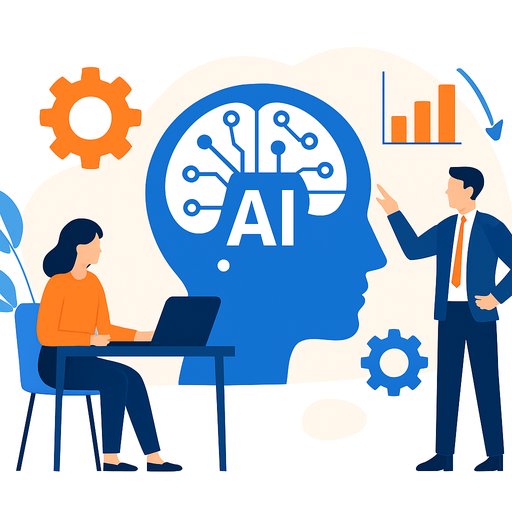Why strategic AI implementation transforms workforces - and why rushed rollouts backfire
HR sets the pace for how AI changes work. Done with intent, AI reduces busywork, improves decisions, and frees people for higher-value tasks. Done in a hurry, it drains trust, increases risk, and stalls adoption.
Use this guide to move with clarity, protect your people, and ship results fast without cutting corners.
What strategic AI changes in your workforce
- From ad-hoc tasks to repeatable systems: documented prompts, workflows, and controls that anyone can use.
- From guesswork to evidence: consistent metrics on quality, time saved, and risk.
- From tool chaos to standards: vetted platforms, shared libraries, and clear usage rules.
- From fear to participation: transparent comms, training paths, and visible wins.
What rushed AI creates
- Shadow tools and data leaks because guidelines are unclear.
- Bias and compliance exposure in hiring and performance decisions.
- Change fatigue from pilots with no purpose or path to scale.
- ROI theater: demos that look good and deliver little.
HR's ownership agenda
- Job architecture and skills taxonomy: define where AI assists work, not replaces accountability.
- Policy and guardrails: data handling, prompt hygiene, confidentiality, and human review.
- Ethics and compliance: bias testing, auditability, and candidate/employee notices.
- Change management: communications, training, and feedback loops.
- Performance and rewards: set clear expectations for AI-assisted output and quality.
90-day plan to prove value without risking trust
- Weeks 1-2: Align and select use cases
Pick 2-3 high-volume, low-risk processes (e.g., job description drafting, policy Q&A, helpdesk triage). Define the outcome, owner, and baseline metrics. - Weeks 3-4: Set guardrails
Create a simple AI use policy, data classification rules, and a human-in-the-loop review. Turn on audit logs and access controls. - Weeks 5-8: Run controlled pilots
Document prompts, steps, and acceptance criteria. Track time saved, error rate, and sentiment. Meet weekly to adjust. - Weeks 9-12: Decide and scale
Standardize what worked, retire what didn't, and publish playbooks. Train the next cohort and expand gradually.
High-impact HR use cases (safe and practical)
- Talent acquisition: Draft inclusive job ads from skills profiles, schedule outreach, and summarize interview notes with bias checks.
- Onboarding: Personalized checklists, first-week Q&A assistants, and equipment requests routed automatically.
- Learning: Create 70/20/10 learning paths from role skills; generate practice scenarios and quizzes.
- HR helpdesk: Policy assistants that cite sources and hand off to a human when uncertain.
- Workforce planning: Skill gap snapshots and internal mobility matches from profiles and project data.
Governance without the bloat
- Use a simple risk tiering: public, internal, confidential, restricted. Block restricted data in prompts.
- Require human review for hiring, promotion, pay, or termination recommendations.
- Bias testing and documentation for selection tools. See the EEOC's guidance on AI in employment here.
- Adopt a lightweight framework for controls and oversight. The NIST AI Risk Management Framework is a good reference here.
- Vendor contracts: data use limits, model updates, uptime, audit rights, and exit plans.
Metrics that prove real value
- Cycle time: hours saved per request, requisition, ticket, or report.
- Quality: error rate, rework rate, compliance findings.
- Adoption: weekly active users, tasks completed with AI assistance.
- People outcomes: candidate satisfaction, new-hire ramp time, employee sentiment.
- Cost: cost per hire, support cost per employee, license spend per active user.
Communication people trust
- State the goal: make work easier and outcomes better, not replace accountability.
- Be specific about what data is allowed and what is off-limits.
- Show before/after examples and name the human reviewer.
- Offer opt-in pilots and clear feedback channels.
Procurement and due diligence checklist
- Security: data residency, encryption, access controls, incident history.
- Model transparency: training data sources, update cadence, known limits.
- Compliance: SOC 2/ISO attestations, bias testing methods, audit logs.
- Usability: admin controls, prompt libraries, analytics.
- Total cost: licenses, usage fees, integration, enablement, and change effort.
Build capability that sticks
Give managers and HR teams practical skills: prompt patterns, review standards, and process redesign. Create a small enablement group to maintain playbooks, coach teams, and track metrics.
If you need structured training for different roles, browse role-based programs here: Complete AI Training - Courses by Job. For new options as they launch, see the latest catalog: Latest AI Courses.
Bottom line
Start with small, safe use cases and clear rules. Prove value, publish the playbook, and expand. Respect people, measure outcomes, and keep a human in the loop where decisions carry risk.
Strategy compounds. Rushing costs more than waiting a week to do it right.
Your membership also unlocks:






